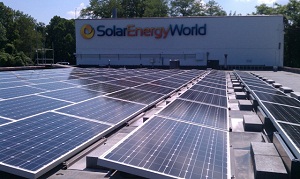Solar Energy World anticipates doubling installations over 2011 in 2012
 Maryland-based Solar Energy World, a residential and commercial solar installer operating primarily in Maryland, New Jersey and Washington, D.C., anticipates that its sales in 2012 will double compared to its sales in 2011. The company attributes the anticipated growth largely to decreased prices of modules and more interest in solar.
Maryland-based Solar Energy World, a residential and commercial solar installer operating primarily in Maryland, New Jersey and Washington, D.C., anticipates that its sales in 2012 will double compared to its sales in 2011. The company attributes the anticipated growth largely to decreased prices of modules and more interest in solar.
The projected growth for Solar Energy World in 2012 builds on top of explosive growth in 2011. The company installed more than 300 solar electric and solar hot water systems in 2011. Which is more than double what was installed in 2010, the company said in a press release.
The growth will come because of three or four things, according to Solar Energy World’s Geoff Mirkin, vice president of Residential Account Customer Relations.
“One, the cost of panels has come down dramatically in last 4 or 5 months. We also have new lease programs on top of our purchase options that are now available,” he said.
The growth will also be attributed to marketing and consumer familiarity with photovoltaics.
“Every year that we’ve been in business we’ve had exponential growth. The whole key is awareness through our marketing and through the industry,” Mirkin said. “A lot of people are more knowledgeable, and there’s more buzz about [solar].”
Some market barriers remain.
“A lot of people want it and don’t know it’s affordable now,” Mirkin said.
People also aren’t aware of all the options for financing that are now available, which include upright purchases, loans, third-party ownership models and more.
“There’s a lot more opportunities that hit a wider spread of people [than previously],” he said.
Although subsidies are being scaled back or sometimes eliminated, Mirkin thinks they will have less impact on the solar industry in 2012 than in the past.
“Originally, solar needed substantial incentives to be financially viable. Because costs have dropped so much, subsidies don’t matter as much as they used to. Solar used to have a 25- to 30- year payback, now we’re seeing a 10- to 11- year payback,” he said.
That’s also prior to adding incentives other than the federal tax credit, and prior to solar renewable energy credits and other incentives.
“When you add the SRECs, it’s substantially lower, 6 to 7 years,” he said.
While the cost of solar has fallen precipitously in past years, Mirkin doesn’t expect that to continue in 2012.
“I think some things may cause it to level off or even jump up a little,” he said.
Still, the cost of solar already is less than what the company projected when it created a five-year plan, he said. The lower than anticipated costs should help the company meets its upped expectations this year.



